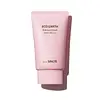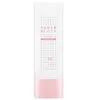What's inside
What's inside
 Key Ingredients
Key Ingredients

 Benefits
Benefits

 Concerns
Concerns

 Ingredients Side-by-side
Ingredients Side-by-side

Water
Skin ConditioningCyclopentasiloxane
EmollientZinc Oxide
Cosmetic ColorantPropanediol
SolventPhenyl Trimethicone
Skin ConditioningCI 77891
Cosmetic ColorantCalamine
AbsorbentPEG-10 Dimethicone
Skin ConditioningDimethicone
EmollientCyclomethicone
EmollientPentylene Glycol
Skin ConditioningDisteardimonium Hectorite
StabilisingLepidium Meyenii Root Extract
Skin ConditioningEpilobium Angustifolium Flower/Leaf/Stem Extract
Skin ConditioningMoringa Oleifera Seed Extract
Skin ConditioningHydrolyzed Vegetable Protein
Skin ConditioningMaltodextrin
AbsorbentMadecassoside
AntioxidantChamomilla Recutita Flower Extract
MaskingCalendula Officinalis Flower Oil
MaskingAnthemis Nobilis Flower Water
MaskingRosa Damascena Flower Water
MaskingMagnesium Sulfate
Aluminum Hydroxide
EmollientHydrogen Dimethicone
Stearic Acid
CleansingDimethicone Crosspolymer
Emulsion StabilisingSorbitan Sesquioleate
EmulsifyingEthylhexylglycerin
Skin ConditioningOctyldodecanol
EmollientEchium Plantagineum Seed Oil
Skin ConditioningSalvia Hispanica Seed Extract
EmollientCentella Asiatica Extract
CleansingPullulan
Cardiospermum Halicacabum Flower/Leaf/Vine Extract
Skin ConditioningHelianthus Annuus Seed Oil Unsaponifiables
EmollientAlcohol
AntimicrobialGlycerin
HumectantHouttuynia Cordata Extract
Skin ConditioningDipropylene Glycol
Humectant1,2-Hexanediol
Skin ConditioningButylene Glycol
HumectantFructooligosaccharides
HumectantSaccharide Hydrolysate
HumectantTocopherol
AntioxidantPhenoxyethanol
PreservativeParfum
MaskingWater, Cyclopentasiloxane, Zinc Oxide, Propanediol, Phenyl Trimethicone, CI 77891, Calamine, PEG-10 Dimethicone, Dimethicone, Cyclomethicone, Pentylene Glycol, Disteardimonium Hectorite, Lepidium Meyenii Root Extract, Epilobium Angustifolium Flower/Leaf/Stem Extract, Moringa Oleifera Seed Extract, Hydrolyzed Vegetable Protein, Maltodextrin, Madecassoside, Chamomilla Recutita Flower Extract, Calendula Officinalis Flower Oil, Anthemis Nobilis Flower Water, Rosa Damascena Flower Water, Magnesium Sulfate, Aluminum Hydroxide, Hydrogen Dimethicone, Stearic Acid, Dimethicone Crosspolymer, Sorbitan Sesquioleate, Ethylhexylglycerin, Octyldodecanol, Echium Plantagineum Seed Oil, Salvia Hispanica Seed Extract, Centella Asiatica Extract, Pullulan, Cardiospermum Halicacabum Flower/Leaf/Vine Extract, Helianthus Annuus Seed Oil Unsaponifiables, Alcohol, Glycerin, Houttuynia Cordata Extract, Dipropylene Glycol, 1,2-Hexanediol, Butylene Glycol, Fructooligosaccharides, Saccharide Hydrolysate, Tocopherol, Phenoxyethanol, Parfum
Water
Skin ConditioningCentella Asiatica Extract
CleansingHomosalate
Skin ConditioningC12-15 Alkyl Benzoate
AntimicrobialTitanium Dioxide
Cosmetic ColorantDipropylene Glycol
HumectantEthylhexyl Salicylate
UV AbsorberCaprylyl Methicone
Skin ConditioningDiethylamino Hydroxybenzoyl Hexyl Benzoate
UV FilterCyclopentasiloxane
EmollientCaprylic/Capric Triglyceride
MaskingLauryl PEG-10 Tris(Trimethylsiloxy)Silylethyl Dimethicone
EmulsifyingCalamine
AbsorbentSodium Chloride
MaskingCetyl PEG/PPG-10/1 Dimethicone
EmulsifyingPolyglyceryl-4 Isostearate
EmulsifyingSilica
AbrasiveBis-Ethylhexyloxyphenol Methoxyphenyl Triazine
Skin ConditioningGossypium Herbaceum
Skin ConditioningCochlearia Armoracia Root Extract
MaskingMadecassoside
AntioxidantPanthenol
Skin ConditioningCyclohexasiloxane
EmollientHexyl Laurate
EmollientPolyglyceryl-4 Diisostearate/Polyhydroxystearate/Sebacate
EmulsifyingAluminum Hydroxide
EmollientStearic Acid
CleansingDisteardimonium Hectorite
StabilisingSorbitan Sesquioleate
EmulsifyingSorbitan Oleate
EmulsifyingDimethicone/Vinyl Dimethicone Crosspolymer
Skin ConditioningDimethicone
EmollientQuaternium-18 Bentonite
Tocopheryl Acetate
AntioxidantPolyhydroxystearic Acid
EmulsifyingIsopropyl Palmitate
EmollientIsostearic Acid
CleansingLecithin
EmollientEthylhexyl Palmitate
EmollientTriethoxycaprylylsilane
Disodium EDTA
1,2-Hexanediol
Skin ConditioningIron Oxides
Parfum
MaskingWater, Centella Asiatica Extract, Homosalate, C12-15 Alkyl Benzoate, Titanium Dioxide, Dipropylene Glycol, Ethylhexyl Salicylate, Caprylyl Methicone, Diethylamino Hydroxybenzoyl Hexyl Benzoate, Cyclopentasiloxane, Caprylic/Capric Triglyceride, Lauryl PEG-10 Tris(Trimethylsiloxy)Silylethyl Dimethicone, Calamine, Sodium Chloride, Cetyl PEG/PPG-10/1 Dimethicone, Polyglyceryl-4 Isostearate, Silica, Bis-Ethylhexyloxyphenol Methoxyphenyl Triazine, Gossypium Herbaceum, Cochlearia Armoracia Root Extract, Madecassoside, Panthenol, Cyclohexasiloxane, Hexyl Laurate, Polyglyceryl-4 Diisostearate/Polyhydroxystearate/Sebacate, Aluminum Hydroxide, Stearic Acid, Disteardimonium Hectorite, Sorbitan Sesquioleate, Sorbitan Oleate, Dimethicone/Vinyl Dimethicone Crosspolymer, Dimethicone, Quaternium-18 Bentonite, Tocopheryl Acetate, Polyhydroxystearic Acid, Isopropyl Palmitate, Isostearic Acid, Lecithin, Ethylhexyl Palmitate, Triethoxycaprylylsilane, Disodium EDTA, 1,2-Hexanediol, Iron Oxides, Parfum
Ingredients Explained
These ingredients are found in both products.
Ingredients higher up in an ingredient list are typically present in a larger amount.
1,2-Hexanediol is a synthetic liquid and another multi-functional powerhouse.
It is a:
- Humectant, drawing moisture into the skin
- Emollient, helping to soften skin
- Solvent, dispersing and stabilizing formulas
- Preservative booster, enhancing the antimicrobial activity of other preservatives
Aluminum Hydroxide is a form of aluminum. It can be naturally found in nature as the mineral gibbsite. In cosmetics, Aluminum Hydroxide is used as a colorant, pH adjuster, and absorbent.
As a colorant, Aluminum Hydroxide may add opacity, or reduce the transparency. Aluminum hydroxide is contains both basic and acidic properties.
According to manufacturers, this ingredient is an emollient and humectant. This means it helps hydrate the skin.
In medicine, this ingredient is used to help relieve heartburn and help heal ulcers.
There is currently no credible scientific evidence linking aluminum hydroxide in cosmetics to increased cancer risk.
Major health organizations allow the use of aluminum hydroxide in personal care products and have not flagged it as a carcinogenic risk at typical usage levels.
Learn more about Aluminum HydroxideWe don't have a description for Calamine yet.
Centella Asiatica Extract (Centella) is derived from an herb native to Southeast Asia. It is famous for its anti-inflammatory and soothing properties.
Centella is rich in antioxidants and amino acids, such as Madecassic Acid and Asiaticoside.
Studies show the compounds in centella help with:
The combination of all these properties makes centella effective at soothing, hydrating, and protecting the skin.
Other great components of centella include Vitamin A, vitamin C, several B vitamins, and Asiatic Acid.
Fun fact: Centella has been used as a medicine and in food for many centuries. As a medicine, it is used to treat burns, scratches, and wounds.
Learn more about Centella Asiatica ExtractCyclopentasiloxane, or D5, is a silicone used to improve texture of products and trap moisture.
D5 is considered lightweight and volatile. Volatile means it evaporates quickly after application. Once evaporated, D5 leaves a thin barrier that helps keep skin hydrated.
It is also an emollient. Emollients help soften the skin and prevent water loss. Silicones create a silky texture in products. D5 helps other ingredients become more spreadable.
Studies show D5 is safe to use in skincare products. We recommend speaking with a skincare professional if you have concerns.
Learn more about CyclopentasiloxaneDimethicone is a type of synthetic silicone created from natural materials such as quartz.
What it does:
Dimethicone comes in different viscosities:
Depending on the viscosity, dimethicone has different properties.
Ingredients lists don't always show which type is used, so we recommend reaching out to the brand if you have questions about the viscosity.
This ingredient is unlikely to cause irritation because it does not get absorbed into skin. However, people with silicone allergies should be careful about using this ingredient.
Note: Dimethicone may contribute to pilling. This is because it is not oil or water soluble, so pilling may occur when layered with products. When mixed with heavy oils in a formula, the outcome is also quite greasy.
Learn more about DimethiconeDipropylene Glycol is a synthetically created humectant, stabilizer, and solvent.
This ingredient helps:
Dipropylene glycol is technically an alcohol, but it belongs to the glycol family (often considered part of the ‘good’ alcohols). This means it is hydrating and gentle on skin unlike drying solvent alcohols like denatured alcohol.
As a masking agent, Dipropylene Glycol can be used to cover the smell of other ingredients. However, it does not have a scent.
Studies show Dipropylene Glycol is considered safe to use in skincare.
Learn more about Dipropylene GlycolDisteardimonium Hectorite comes from the clay mineral named hectorite. It is used to add thickness to a product.
It can also help stabilize a product by helping to disperse other ingredients.
Hectorite is a rare, white clay mineral.
Learn more about Disteardimonium HectoriteMadecassoside comes from the super popular skin-soothing ingredient, Centella asiatica. It is one of four active compounds found in the extract of Centella Asiatica.
Madecassoside has antioxidant, anti-inflammatory, and hydrating properties. It contains fatty acids, amino acids, beta-carotene, and phytochemicals.
One study found using Madecassoside with ascorbic acid helped reduce the signs of aging and improved skin hydration.
Learn more about MadecassosideParfum is a catch-all term for an ingredient or more that is used to give a scent to products.
Also called "fragrance", this ingredient can be a blend of hundreds of chemicals or plant oils. This means every product with "fragrance" or "parfum" in the ingredients list is a different mixture.
For instance, Habanolide is a proprietary trade name for a specific aroma chemical. When used as a fragrance ingredient in cosmetics, most aroma chemicals fall under the broad labeling category of “FRAGRANCE” or “PARFUM” according to EU and US regulations.
The term 'parfum' or 'fragrance' is not regulated in many countries. In many cases, it is up to the brand to define this term.
For instance, many brands choose to label themselves as "fragrance-free" because they are not using synthetic fragrances. However, their products may still contain ingredients such as essential oils that are considered a fragrance by INCI standards.
One example is Calendula flower extract. Calendula is an essential oil that still imparts a scent or 'fragrance'.
Depending on the blend, the ingredients in the mixture can cause allergies and sensitivities on the skin. Some ingredients that are known EU allergens include linalool and citronellol.
Parfum can also be used to mask or cover an unpleasant scent.
The bottom line is: not all fragrances/parfum/ingredients are created equally. If you are worried about fragrances, we recommend taking a closer look at an ingredient. And of course, we always recommend speaking with a professional.
Learn more about ParfumSorbitan Sesquioleate is derived from sorbitol and oleic acid. It is an emulsifier and prevents ingredients from separating.
Specifically, this ingredient is a water-in-oil emulsifier, meaning it helps water dissolve into oil.
Some studies suggest this ingredient may cause irritation in some people. If you are unsure, it is best to patch test.
This ingredient may not be Malassezia folliculitis, or fungal-acne safe.
Learn more about Sorbitan SesquioleateStearic Acid is a fatty acid. It is an emollient, emulsifier, and texture enhancer.
As an emollient, stearic acid helps soften skin. It aids the skin's protective barrier by preventing water loss. It also provides a gentle cleansing effect without stripping away natural oils.
Stearic acid may also be used to enhance the texture of products. It can add volume and stabilize ingredients such as water and oil. This can help water and oil ingredients from separating.
Sources of stearic acid include animal or vegetable fats/oils such as coconut or shea. It can be naturally found in butter, cocoa butter, shea butter, vegetable fats, and animal tallow.
This ingredient may not be Malassezia folliculitis, or fungal-acne safe.
Learn more about Stearic AcidWater. It's the most common cosmetic ingredient of all. You'll usually see it at the top of ingredient lists, meaning that it makes up the largest part of the product.
So why is it so popular? Water most often acts as a solvent - this means that it helps dissolve other ingredients into the formulation.
You'll also recognize water as that liquid we all need to stay alive. If you see this, drink a glass of water. Stay hydrated!
Learn more about Water